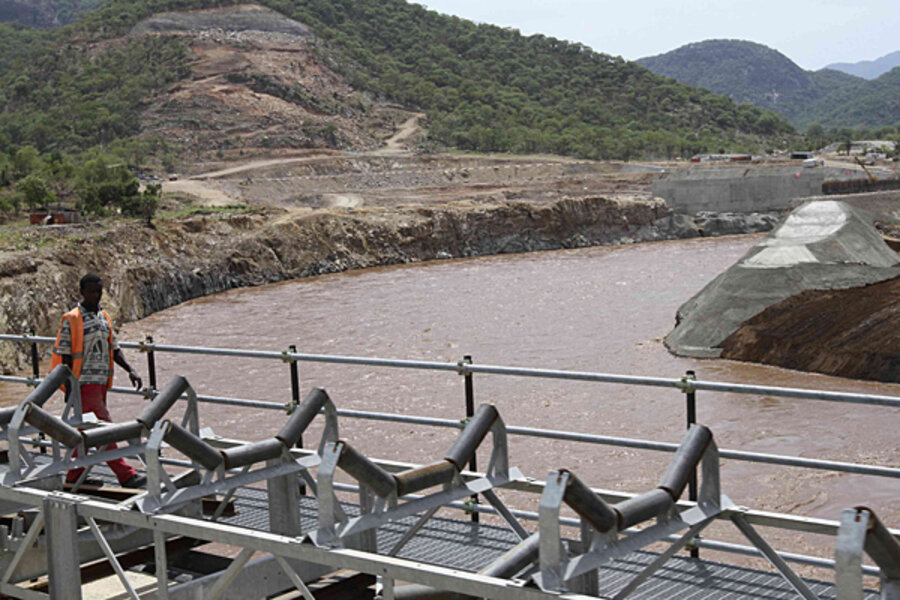Ethiopia: Big Nile dam could ease Africa power failures
Loading...
| Assosa, Ethiopia
The book, a history of Hoover Dam, fell from the dashboard as Simegnew Bekele drove through the rugged mountains where the engineer is leading construction work on Ethiopia's massiveNile River dam.
"This book," he said, picking it up, "I am reading it now ... It's a fascinating story. This dam too (has) a history one day someone will write about."
Simegnew's sentiment illustrated the great expectations of a dam that has raised tensions between this Horn of Africa nation and Egypt, which is concerned the ongoing project will diminish its share of Nile River waters. Reading the book, a gift from Ethiopians he met in New York recently, the engineer has come to see similarities between the Ethiopian dam-in-progress and Hoover Dam, the Great Depression-era project that in its time became an icon of American enterprise under difficult economic conditions.
"Hoover Dam was constructed when America was (in) depression," Simegnew said. "It was an enormous success. I am sure our dam too will herald a bright future for this country and also for the whole region."
Despite the concerns of Nile-dependent Egypt, Ethiopia —whose economy suffers frequent power failures —has vowed to proceed with the dam that would become the biggest hydro-electric power station in Africa. In May,Ethiopia started to divert Nile waters to make way for the $4.2 billion dam which, when it is finished, will have the capacity to produce 6,000 megawatts of electricity. Ethiopia's national electricity corporation says potential buyers of Ethiopia's electricity will include the two Sudans, Kenya, Djibouti, Somalia, Uganda and even wary Egypt.
In Ethiopia's Benishangul-Gumuz region near Sudan, some 800 kilometers (500 miles) from the capital, workers labor under intensely hot conditions and gigantic machines smash boulders in order to make the dama reality by July 2017. Even as Egyptian and Ethiopian diplomats talk over the dam's impact on the volume of Blue Nile waters flowing to Egypt, construction work is proceeding apace here in a sign of Ethiopia'sdetermination to resist Egyptian pressure. Some 5,000 Ethiopians, joined by 200 expatriates from 20 nations, work in shifts 24 hours a day. Visitors here have to go through multiple security checkpoints that are manned by soldiers wearing "anti-guerrilla" tags on their fatigues. The Italian construction firm Salini is building thedam while the Chinese company Electric Power Equipment and Technology Co. Ltd. is building power lines for it.
Simegnew, the engineer, told reporters last week that some of the diverted Nile waters are accumulating in a temporary coffer dam, and officials say that the filling of the reservoir will start next year. Power lines to connect the dam's output with the national grid are being put up, and cables from the national grid extend to Djibouti, Sudan and, later, Kenya.
"During the filling of the reservoir, which will take five to six years, we won't have any fixed impoundment rate to make sure the water flow downstream will not be significantly affected," Simegnew said.
Ethiopia's Nile project has won the support of upstream countries in East and Central Africa that have been meeting under the banner of the Nile Basin Initiative, which endorsed the new Nile River Cooperative Framework Agreement. That accord, ratified last month by Ethiopia's parliament, was conceived to replace the 1929 treaty written by Britain that awarded Egypt veto power over other countries' Nile projects. Sudan and Egypt signed a deal in 1959 splitting the Nile waters between them without giving other countries consideration. Egyptian politicians have suggested attacks against Ethiopia to sabotage the dam, and Egyptian President Mohammed Morsi last month warned that "all options are open" to challenge the project.
Ethiopian Prime Minister Hailemariam Desalegn said last week that, while he was willing to accommodate Egypt's concerns, the continued constructing of the dam and its size are "red lines" that will not be crossed by the negotiations.
If the dam is completed without incident, it would be a remarkable achievement for Ethiopia's leaders who dreamed of something big and wanted an equally grand name for the dam. Originally a secret project called X, the dam was later called the Grand Ethiopian Renaissance Dam.
David Shinn, former U.S. ambassador to Ethiopia, said he doubted Egypt's dispute with Ethiopia over the Nile River would degenerate into armed conflict.
"Following long periods of silence, there are periodic outbursts as we have seen in the past month," said Shinn, who is now a professor at George Washington University's Elliott School of International Affairs. "I expect this trend to continue but not to result in conflict between the two countries."
The Ethiopian government, which secured a $1 billion loan from China for power lines for the Nile dam, says it will continue to raise more funds domestically. Government employees have for the second time paid their one-month salary to buy bonds the government is selling. Private banks are ordered by the central bank to buy bonds worth millions of the Ethiopian birr.
Yilma Seleshi of the Ethiopian Water Resource Institute says the dam would consistently bring in hard currency for at least a century, returning the massive investment it is requiring. In his study presented during a meeting at Ethiopia's Addis Ababa University last week, he estimated that Ethiopia would earn 2 million euros in daily income from power sales to neighboring countries.







